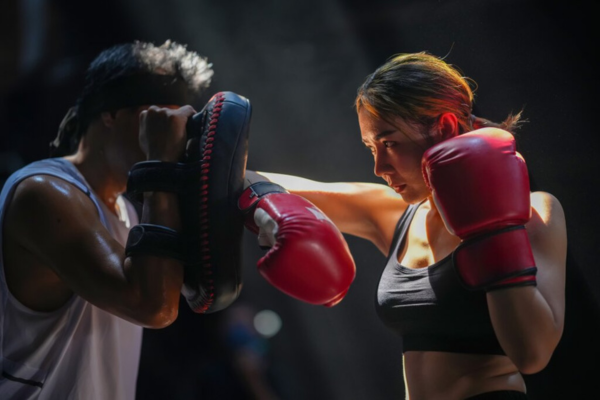Training with Injuries: What You Can Do and What You Should Avoid

Getting injured during training is frustrating. You’re in a rhythm, making progress, and suddenly you have to hit the brakes. However, an injury doesn’t have to be the end of the road. In fact, if managed well, you can keep moving responsibly, speed up recovery, and come back mentally stronger. This blog explains what you should and shouldn’t do when training with injuries, with practical tips, insights, and tools especially for martial artists.
At Fightstyle, we believe martial arts are more than just physical strength. It’s about character, discipline, and smartly handling setbacks. Injury periods are when you can show what kind of fighter you really are.
Injuries Are Part of the Game – But How to Handle Them Responsibly?
In intense sports like kickboxing, MMA, and boxing, injuries are almost inevitable. The question isn’t if you get injured, but how you deal with it. An injury doesn’t have to be a pause button for your ambitions, as long as you make the right choices.
Common injuries include strains, muscle injuries, ankle sprains, or shoulder overload. Some heal quickly; others last longer—especially if ignored.
Important: Pain is a signal, not an enemy. Training through pain without adjustments risks worsening or permanent damage. A smart fighter listens to their body and adapts where needed.
What You Can Do When Injured
 Training with injuries doesn’t mean sitting on the bench waiting. Often, there are still ways to stay active without harming recovery. It’s about training smart, not hard.
Training with injuries doesn’t mean sitting on the bench waiting. Often, there are still ways to stay active without harming recovery. It’s about training smart, not hard.
Train around your injury: ankle problems? Focus on upper body exercises. Shoulder issues? Work on legs or do light cardio. Swimming, cycling, or technique drills can be good alternatives, depending on your injury.
Recovery activities like mobility training, breathing exercises, and gentle yoga also help keep you fit. Don’t forget nutrition and sleep are crucial for recovery—think extra protein, plenty of water, and supplements like magnesium.
Common Mistakes When Training with Injuries
The biggest mistake? Ignoring pain. The “pain is gain” myth is persistent—and dangerous. Pain isn’t growth, it’s warning. Ignoring it often worsens the problem.
Another mistake is self-diagnosis. YouTube rehab routines might work for some, but harm others. Always seek professional guidance for serious complaints, like a sports physiotherapist.
Finally: trying to do too much too soon. Many fighters want to jump back in full force immediately. Recovery takes time. Build up slowly, focus on basics, and choose longevity over speed. Your body will thank you.
How to Prevent Recurring Injuries
Prevention starts with mindful training. A good warm-up and cool-down aren’t luxury, but essential. Always begin with mobility exercises and light cardio. Finish with stretching and breathing exercises.
Technique matters more than brute force. Many injuries stem from bad movements, overload, or poor posture. Work with a trainer on your technique, even if you’re experienced.
Invest in good gear. Poorly fitting shin guards, worn gloves, or unstable shoes increase injury risk. Always choose quality martial arts equipment—your safety is worth it.
Tools to Support Responsible Training
 Many aids can support your recovery. Think braces or bandages for extra knee or ankle stability. They give you the confidence and protection you need.
Many aids can support your recovery. Think braces or bandages for extra knee or ankle stability. They give you the confidence and protection you need.
Foam rollers and massage guns help loosen knots and stimulate blood flow. A short self-massage post-training can make a big difference in recovery.
Your clothing matters too. Choose breathable, elastic martial arts wear that supports movement instead of restricting it. Comfort isn’t just nice—it prevents unnecessary strain on joints and muscles.
The Role of Your Trainer and Physiotherapist
You don’t have to do it alone. A good trainer knows your body, goals, and pitfalls. Be open and create a recovery plan together to keep moving responsibly.
A physiotherapist is your best friend when training injured. They help assess what you can do safely and guide your exercises without risk. Don’t wait too long to get help—prevention is better than cure.
Within the Fightstyle community, you’ll find support. Share your journey on socials, ask questions, and learn how others cope with setbacks. Stronger together—that’s fighting with heart.
Stay Involved in Your Martial Art—even with an Injury
You don’t have to be sidelined when injured. Plenty of ways to stay engaged exist. Watch training videos, work on mindset, read about fight strategy, or analyze fights.
You can also share your recovery story. It helps you and teammates facing the same situation. Being open keeps you part of the community and motivated.
Remember: every injury is a chance to come back stronger—not just physically but mentally. Let this period build you into an even better version of yourself.
 Nederlands
Nederlands English
English Deutsch
Deutsch Français
Français


Interessant stuk! Hoe herkennen jullie het verschil tussen gewone spierpijn en een blessure waarbij je echt moet stoppen met trainen?
Leave a comment